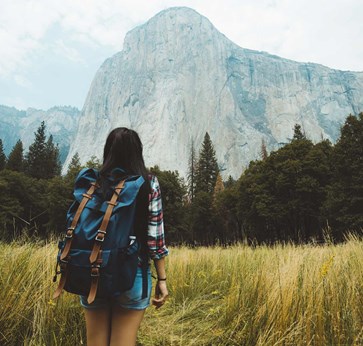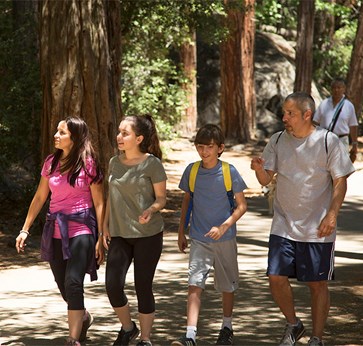Constant Change, Constant Thrill
The mountains are a place of constantly changing and unpredictable conditions—which is part of Yosemite’s allure. With elevations that range from 2,000 feet over 13,000 feet, it can feel like summer at low elevations and winter on the mountain peaks. Generally, the Sierra is known for its abundant sunshine—but rainstorms and snowstorms do happen. Below is an overview of Yosemite’s four seasons—but in any season, it’s smart to plan ahead and be prepared. Check current weather conditionshere.
Winter

Because nearly three-quarters of the annual precipitation happens in the winter as snow and rain, it’s typically cold and damp from November to March. The higher you go, the earlier you’ll find snow and the longer it will take to melt—which means snowy peaks from September through April and even through May or June. It’s not uncommon for the higher elevations to receive dozens of feet of snow throughout the winter.
Spring
 在春天,优胜美地的地貌发生了巨大的变化,因为雪开始从低海拔地区融化到高海拔地区。事实上,有时海拔较高的小径要到7月份才能通行。随着积雪的融化,约塞米蒂著名的瀑布开始显示出它们的力量,高峰流量通常发生在5月。Daytime temperatures can reach into the 70s Fahrenheitand dip down to below freezing after the sun sets.
在春天,优胜美地的地貌发生了巨大的变化,因为雪开始从低海拔地区融化到高海拔地区。事实上,有时海拔较高的小径要到7月份才能通行。随着积雪的融化,约塞米蒂著名的瀑布开始显示出它们的力量,高峰流量通常发生在5月。Daytime temperatures can reach into the 70s Fahrenheitand dip down to below freezing after the sun sets.
Summer

At lower levels in the park, Summers are warm, dry, and sunny—with the little rainfall that does happen coming in the form of powerful but brief afternoon thunderstorms that can produce lightning and hail. During the peak of summer, days at lower elevations can reach 100 degrees Fahrenheitbefore dipping down into the 50s or even 40s at night. Nights in Yosemite National Park are cherished for their clear skies and incomparable stargazing.
在海拔较高的地方,如白狼小屋、图奥勒姆草地和高塞拉营地通常会经历寒冷的夜间温度,除非在7月。这些地方的白天也不一定热。
Fall
 Warm days and cool (or even cold) nights take over as the Sierra transitions to fall. September and October tend to be filled with bright, cloudless days which make for incredible views. By fall, most of the waterfalls at Yosemite have slowed to a trickle or dried up entirely. By late fall, the snow can start falling in the park’s higher elevations—a sign that winter isn’t far behind.
Warm days and cool (or even cold) nights take over as the Sierra transitions to fall. September and October tend to be filled with bright, cloudless days which make for incredible views. By fall, most of the waterfalls at Yosemite have slowed to a trickle or dried up entirely. By late fall, the snow can start falling in the park’s higher elevations—a sign that winter isn’t far behind.
While many park visitors are content to simply sit back and enjoy the scenery, there is a variety offall activitiesfor park visitors to enjoy. Pleasantly brisk days provide the perfect atmosphere forbicycling,hiking,golf,rock climbing,horseback ridesandsightseeing tours. Yosemite is considered one of the world's premier rock climbing destinations and a leisurely bike ride in Yosemite Valley is an fun way to view Yosemite's granite peaks and fall color. In the evenings, visitors can still enjoy outdoor programs such asStarry Skies Over Yosemite- Yosemite is famous for its dark night skies. Foodies and wine lovers are invited to join us forVintners' Holidayswinemakers dinner atThe Ahwahnee, which allows you to learn about wine from some of California’s most celebrated winemakers.
Learn more about Yosemite National Park seasons, via National Park Service website:





